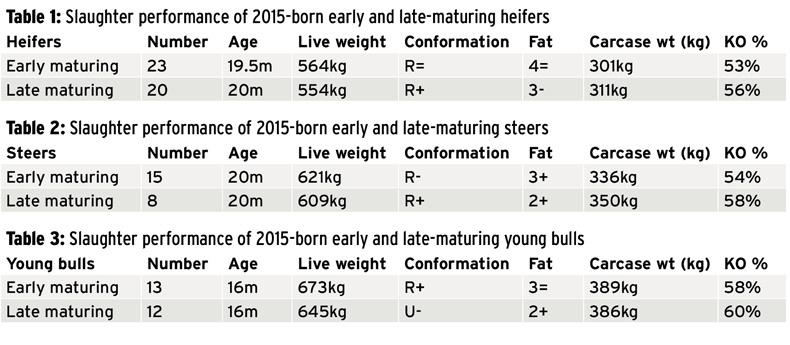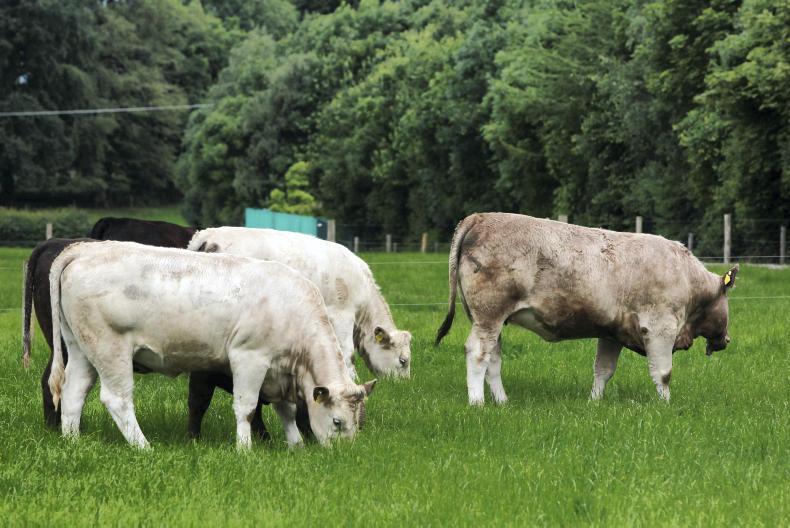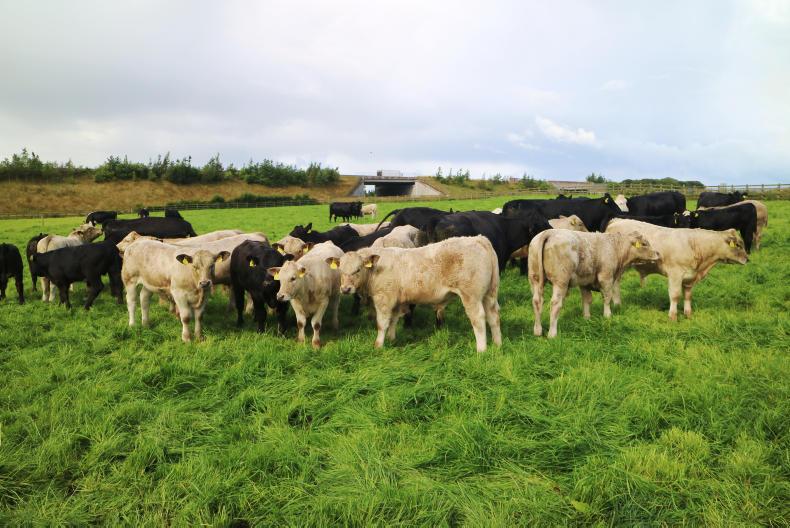The Derrypatrick herd got off to a flying start in terms of calving performance in 2016, with 91 cows calving in a 10-week period. Angus-sired calves averaged 43kg at birth, while Charolais-sired calves averaged 55kg with mortality at birth recorded at just 2%. Mortality at 28 days increased to the national average at 6.5% with three calves lost – one due to a broken leg, another to a case of scour and one with a brain deformation.
As was the case throughout the country, turnout was stop-start, with weanlings turned out on 22 February but rehoused due to very heavy rainfall until 15 March. Cows and calves went to grass on 10 March and after this the herd had a largely successful grazing season, recording growth of 13t DM/ha. Despite the slow start, steers gained an average of 1kg from turnout to the end of August. Early maturing progeny repeated their positive performance in 2016, with heifers gaining 0.89kg at grass, 0.1kg higher than their late-maturing counterparts. Concentrates were introduced at the end of August to underpin performance and target getting as many cattle killed off grass as possible.
Slaughter performance of heifers is detailed in Table 1. All the early maturing heifers were drafted off grass with a percentage of the late-maturing animals brought indoors for a short finishing period. Teagasc explains that the late-maturing heifers delivered on average 10kg heavier carcases but point out that as they consumed 200kg more concentrates. The additional return was cancelled out with the exception of ensuring animals met the desired fat cover.
However, the benefit of a higher kill-out also needs to be taken into account along with likely helping to get more animals into the R+ bracket and securing an additional 6c/kg on the grid price.
Table 2 details slaughter performance of steers. There were lower numbers in each group as half the herd is set up to slaughter half the male progeny as bulls in an under-16-month system. Again, the early maturing steers were on average heavier at slaughter but a 4% reduction in kill-out compared with the late maturing animals resulted in a 14kg lighter carcase weight. Teagasc points out that the late-maturing animals consumed 200kg more concentrates. This delivered a return on kill-out but also, importantly, the average fat cover was 2+, meaning some animals fell out of spec, which could have been even greater had concentrates not been fed.
The performance of young bulls is listed in Table 3. Slaughtered in June 2016, the early maturing bulls delivered a marginally higher carcase weight. Fat cover at an average of 2+ was also two scores lower in the late-maturing bulls. Total concentrate intake was 1.8t/head.
The performance of early maturing progeny sired by two Angus stock bulls was very positive and it should be pointed out that these bulls have a favourable terminal index of €97 and €106 respectively and carcase weight figures of 20kg and 25kg. The two Charolais stock bulls possess a terminal index of €157 and €124 with carcase weight figures of 34kg and 28kg respectively.
Gross margin
The farm’s gross margin reduced by €132/ha in 2016 to €1,054/ha and is being influenced by the average beef price reducing and an inventory change with fewer cows, weanlings and stock bulls present at year end. Teagasc still sees the €1,500/ha gross margin target set as achievable but says it will require higher kilos of beef produced per hectare, a higher beef price and no inventory changes.
Breeding issue
Pregnancy rate of cows and replacement heifers was 86 out of 105 animals or 82%. Breeding performance in mature cows was hit by a suspected disease issue. Although there were only four cows not pregnant at any stage during the breeding season, there were 18 barren animals at the end of the year out of the 72 cows selected for breeding. In percentage terms, a conception rate of approximately 95% was initially achieved but the barren rate resulted in an ultimate pregnancy rate of 75%, much lower than the favourable breeding performance in 2015 of a 97% pregnancy rate and 93% in 2014. Management was the same across all groups and the fact there was a pregnancy rate of 97% in replacement heifers confirms an underlying issue with the cow group.
The herd was scanned regularly over the season, with the first issues cropping up in the August scan. There were eight cows scanned empty in August from 46 cows served once from 3 May to 30 June, five of which were suggestive of embryo or foetal loss. Further issues were identified in the next scan in October. From 26 animals served a second time between 10 May and 15 July, seven were scanned empty with two or three again suggestive of embryo or foetal loss. At the same scanning, there were five animals that were served a third time between 6 June and 8 July. Of these five, three were empty and again indicative of embryo or foetal loss.
Teagasc veterinary specialist Dr Ríona Sayers carried out a full herd health examination of the 62 cows (empty cows were slaughtered) remaining in the herd in early January and recently presented the results to the Teagasc Beef Stakeholder group. A full range of tests were completed including BVD (antibody and virus), IBR, Neosporosis, liver fluke and Johne’s. Cows were not tested for leptospirosis and salmonellosis due to vaccination.
Results
There were no BVD virus positive animals identified but 46 of 62 cows recorded high positive antibody results which Riona says is quite a high proportion, given implementation of the national eradication scheme, and the brand of vaccine administered which is less likely to interfere with antibody test results. There were seven animals antibody positive for IBR which is not seen as causative for such a high barren rate, especially as all cows are vaccinated. There was a single Neospora antibody positive cow. With regard to Johne’s testing, antibody positives results were returned in 11 cows but Ríona says this could be influenced by a recent TB test, and in any case, is still not likely to be the cause of embryo losses.
A similar range of tests was carried out for replacement heifers. Eight out of the 32 heifers returned low to moderate BVD antibody positive results, a considerably lower proportion than the cow group, two IBR positives and three Johne’s positives.
Teaser bulls were used to identify cows in heat and the five teaser bulls used in Grange in 2016 were tested for a similar disease range, including leptosporosis and salmonellosis as teasers were unvaccinated. One teaser bull showed up with an antibody positive for BVD while all five bulls also showed up as antibody positive for leptospirosis, although not vaccinated. Three bulls were purchased from one farm including the BVD antibody positive.
As such, Ríona says that it is less likely that the animal came in contact with BVD on that farm, rather that he came in contact with it during transit or through some other animal contact, post-movement. The antibody-positive bull running with the herd could indicate BVD virus circulation in the cow herd which can result in embryo loss. An aspect preventing Ríona from definitely making this assumption is that none of the 84 weanlings running with the cows showed up with a BVD antibody or virus-positive result when tested in January.
If BVD wass the cause then there could be persistently infected (PI) calves born this spring but again Ríona says this may not be a definite. As more and more herds nationally contain animals that have never met BVD virus, BVD may now present with a different range of clinical signs than we have not been used to over the past number of decades. Farmers must remain vigilant, employ good biosecurity measures, and vaccinate.
The positive result for lepto in the five bulls that were never vaccinated is said to be presenting an unusual picture but as the herd is vaccinated this cannot, along with BVD, be identified as the definite cause for the poor reproductive performance.
As 95% of cows initially went in-calf, the cows themselves were not identified as primary contributors to poor pregnancy rates. The exact cause of the sub-optimal breeding performance in Derrypatrick in 2016 is, therefore, not known as yet, or may never be truly known, unless this year’s calf crop provide some further clues.
In conclusion, Ríona says that to prevent issues like this in the future or for other herds, biosecurity measures must be implemented. Ideally this would involve operating a closed herd, but where animals do need to be purchased in, Ríona says that there are three vital components to implement – biosecurity measures, vaccination and diagnostics.
This is a vital component and is a feature all commercial herds should consider in the development of a robust whole herd health plan.
John Heslin became the lead researcher in the demonstration herd in January 2017 and will oversee the implementation of the new focus of the herd – to compare progeny performance from high terminal and high maternal bred sires. The farm is also partaking in the Teagasc Grass10 target which focuses on achieving 10 grazing rotations and 10t of grass produced. The farm has set itself a target of growing 13t DM/ha with 75% utilisation and an average of 10 rotations.
Biosecurity measures are also being reviewed, with a biosecurity programme put in place along with quarantining, testing and implementing a full health programme for purchased animals. 2017 will also see the commencement of a new clover trial which John says will be based on the trial in place in recent years in Moorepark. Clover will be incorporated into half the farm area in April/May, with sward performance evaluated at 200kg nitrogen per hectare and also possibly at an annual allocation of 150kg nitrogen.













SHARING OPTIONS